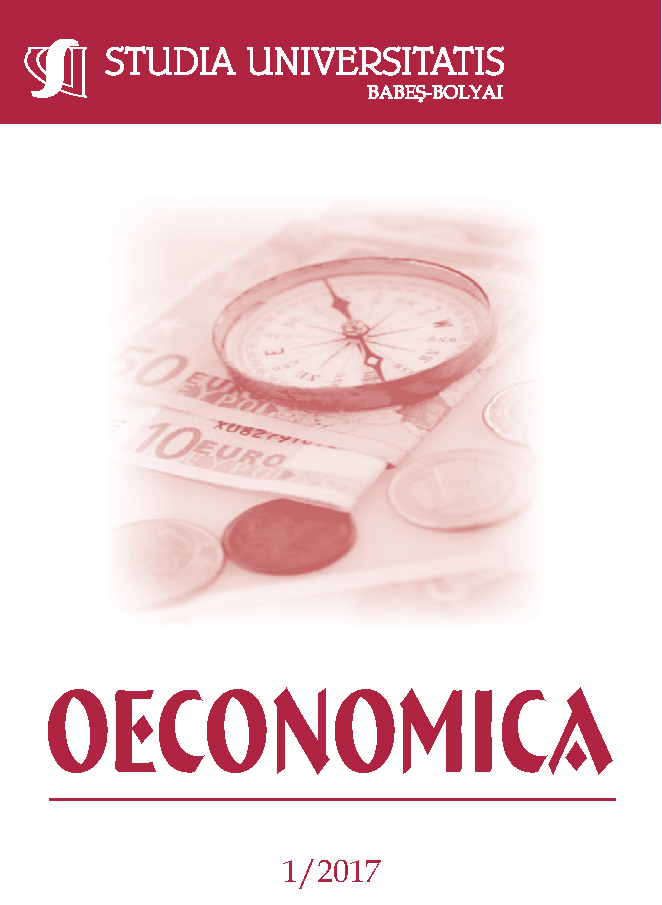A GENDER AND MARITAL STATUS ANALYSIS OF HOUSEHOLD INCOME IN A LOW-INCOME TOWNSHIP
Keywords:
poverty, measurements, gender, marital status, incomeAbstract
https://doi.org/10.1515/subboec-2017-0002
The analysis of income at household level is highly important for understanding the poverty and for supporting the efforts to deal with poverty. Poverty measures can be calculated from a multitude of approaches. A common approach is to use household income and draw a minimum level of income required for a household to be considered above or below poverty. This paper looked at income at household level from a gender perspective and a marital status perspective in order to draw conclusions of the nature of household’s characteristics that are associated with higher or lower income as a proxy for poverty. Based on data collected in a low income township in South Africa, the regression analysis was applied to investigate the differences between different marital statuses and gender and how they are associated with different levels of income. The regression results reveal that female headed households have, on average, lower incomes compared to male headed households, and also, that married heads of households have higher incomes compared to the single, divorced, and widowed. The widowed had the lowest average income.
JEL classification: I32
References
Atkinson, K. E. (2008). An introduction to numerical analysis. John Wiley & Sons.
Alkire, S. (2009). Multidimensional Measures of Poverty & Well-being 1, 1–39.
Alkire, S., Foster, J. E. (2013). A Report on Mexican Multidimensional Poverty Measurement (No. 60). Oxford.
Barrett, C. B., Carter, M. R. (2006). The economics of poverty traps and persistent poverty: Empirical and policy implications. Journal of Development Studies, 42(2), 178–199. http://doi.org/10.1080/00220388.2013.785527
Brandolini, A., Magri, S., Smeeding, T. M. (2010). Asset-based measurement of poverty. Journal of Policy Analysis and Management, 29(2), 267–284. http://doi.org/10.1002/pam.20491
Chant, S. (2008). The “Feminisation of Poverty” and the “Feminisation” of Anti-Poverty Programmes: Room for Revision? Journal of Development Studies, 44(2), 165–197. http://doi.org/10.1080/00220380701789810
Chant, S. H. (2006). LSE Research Online Working paper Female household headship and the feminisation of poverty : facts, fictions and forward strategies.
Dollar, D.,and Kraay, A. (2000). Growth is good for the poor. Washington, DC: World Bank
Dubihlela, J., Dubihlela, D. (2014). Social Grants impact on poverty among the Female-Headed Households in South Africa: A case analysis. Mediterranean Journal of Social Sciences, 5(8), 160.
Gove, W. R. (1973). Sex, marital status, and mortality. American Journal of Socialogy, 79, 45–67.
Grobler, W. C. J., Dunga, S. H. (2014). An Analysis of the Perceptions of Causes of Poverty among Grant Receiving and Non-Grant Receiving Households, (October), 1–9.
Helsing, K., Moyses, S., Comstock, G. (1981). Factors associated with mortality after widowhood. Amer. J. Public Health, 71(8), 802–809. Retrieved from http://ezproxy.lib.utexas.edu/login?url=http://search.ebscohost.com/login.aspx?direct=true&db=psyhref&AN=AJPH.GA.HJB.HELSING.FAMAW
Kinoshita, Y., Guo, F. (2015). What can boost female labor force participation in Asia?. International Monetary Fund
Kobrin, F. E., Hendershot, G. (1977). Do family ties reduce mortality? Evidence from the United States, 1966-1968. Journal of Marriage and Family, 39, 737–745.
Makhalima, J. L., Sekatane, M. B., Dunga, S. H. (2014). Determinants of Child Poverty in a South African Township: A Case of Boipatong Township. Mediterranean Journal of Social Sciences, 5(1). http://doi.org/10.5901/mjss.2014.v5n1p235
Mergenhagen, P. M., Lee, B. A., Gove, W. R. (1985). Till death do us part: Recent changes in the relationship between marital status and mortality. Sociology and Social Research, 70, 53–56.
Meyer, B. D., Sullivan, J. X. (2012). Identifying the Disadvantaged: Official Poverty, Consumption Poverty, and the New Supplemental Poverty Measure. Journal of Economic Perspectives, 26(3), 111–136. http://doi.org/10.1257/jep.26.3.111
Meyer, D.F., Dunga, S.H. (2014). The Determinants of Life Satisfaction in a Low-Income, Poor Community in South Africa. Mediterranean Journal of Social Sciences, 5(13). http://doi.org/10.5901/mjss.2014.v5n13p163
Ravallion, M. (1996). Issues in measuring and modelling poverty.
Ravallion, M. (2001). Growth, inequality and poverty: looking beyond averages. World development, 29(11), 1803-1815.
Sekhampu, T. J. (2013). Determination of the factors affecting the food security status of households in Bophelong, South Africa. The International Business & Economics Research Journal (Online), 12(5), 543.
Sen, A. (1981). Poverty and famines: an essay on entitlement and deprivation. Oxford University. http://doi.org/10.1016/0147-5967(83)90075-6
Trovato, F., Lauris, G. (1998). Marital status and mortality in Canada: 1951-1981. Journal of Marriage and the Family, 51, 907–922.
Zick, C. D., & Smith, K. R. (1991). Marital Transitions, Poverty, and Gender Differences in Mortality. Journal of Marriage and Family, 53(2), 327–336. http://doi.org/10.2307/352902
Society at a Glance 2016, OECD Publishing, Paris; Philipov, D, and J. Dorbritz. (2003) Demographic consequences of economic transition in countries of Central and Eastern Europe. Strasbourg: Council of Europe Publishing
Woolard, I., & Klasen, S. (2005). Determinants of income mobility and household poverty dynamics in South Africa. Journal of Development Studies, 41(5), 865-897.
Downloads
Published
How to Cite
Issue
Section
License
Copyright (c) 2017 Studia Universitatis Babeș-Bolyai Oeconomica

This work is licensed under a Creative Commons Attribution-NonCommercial-NoDerivatives 4.0 International License.



